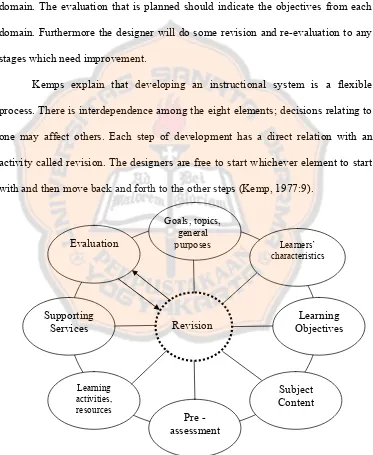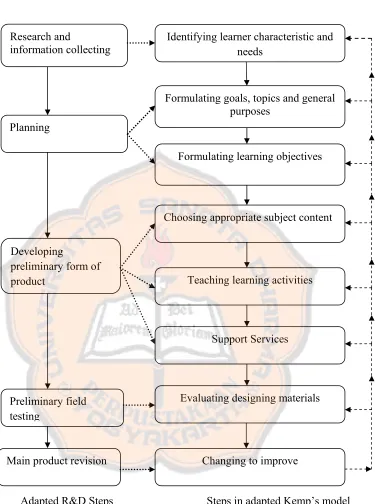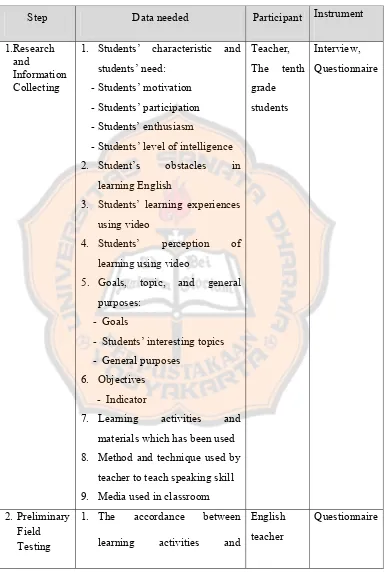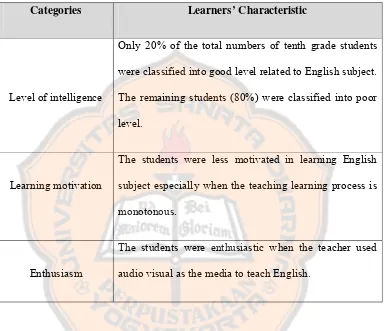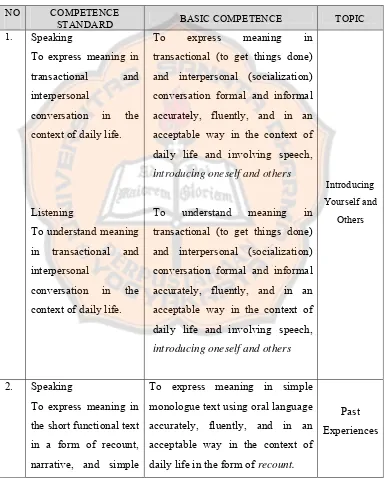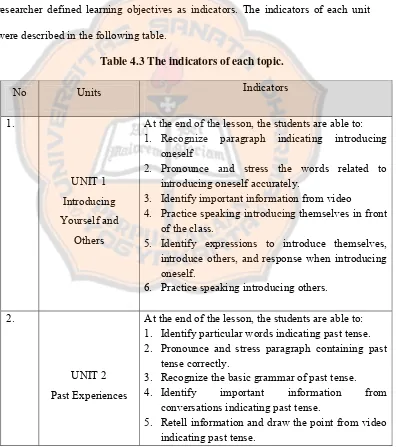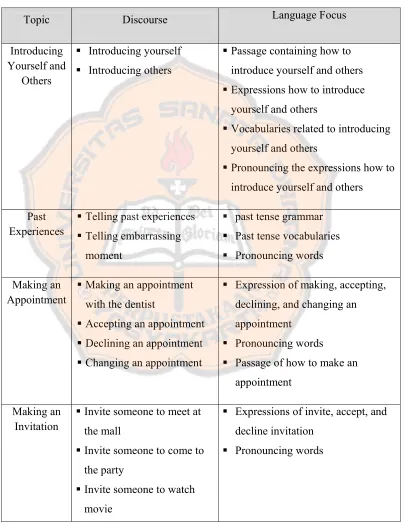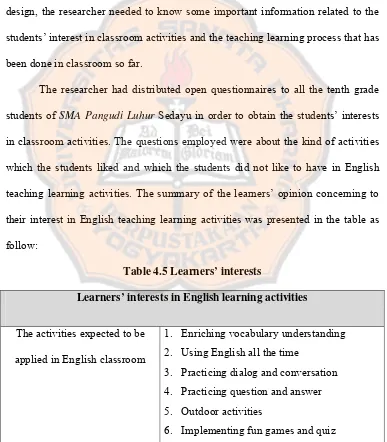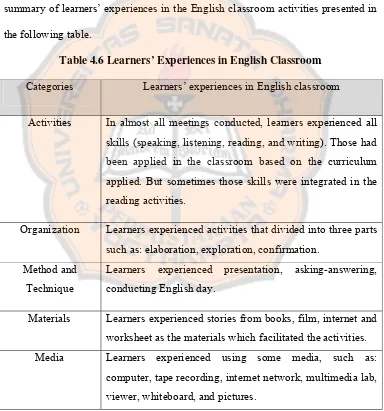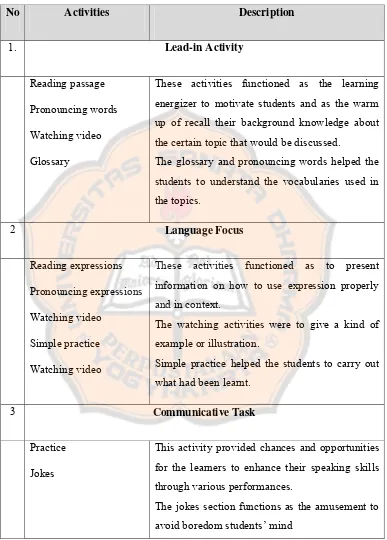DESIGNING SUPPLEMENTARY INTERACTIVE SPEAKING MULTIMEDIA USING VIDEO FOR THE TENTH GRADE STUDENTS
OF SMA PANGUDI LUHUR SEDAYU
A THESIS
Presented as Fulfillment of the Requirements to Obtain the Sarjana Pendidikan Degree
in English Language Education
By
HERONIMUS DITA PRAMUDYANTORO
Student Number: 061214058
ENGLISH LANGUAGE EDUCATION STUDY PROGRAM
DEPARTMENT OF LANGUAGE AND ARTS EDUCATION
FACULTY OF TEACHERS TRAINING AND EDUCATION
SANATA DHARMA UNIVERSITY
DESIGNING SUPPLEMENTARY INTERACTIVE SPEAKING MULTIMEDIA USING VIDEO FOR THE TENTH GRADE STUDENTS
OF SMA PANGUDI LUHUR SEDAYU
A THESIS
Presented as Fulfillment of the Requirements to Obtain the Sarjana Pendidikan Degree
in English Language Education
By
HERONIMUS DITA PRAMUDYANTORO
Student Number: 061214058
ENGLISH LANGUAGE EDUCATION STUDY PROGRAM
DEPARTMENT OF LANGUAGE AND ARTS EDUCATION
FACULTY OF TEACHERS TRAINING AND EDUCATION
SANATA DHARMA UNIVERSITY
O Lord, Open
my lips and
my mouth will
declare your
praise
Psalms 51:15
STATEMENT OF WORK’S ORIGINALITY
I honestly declare that this thesis, which I have written, does not contain the work or parts of other people, except those cited in the quotations and references, as a scientific paper should.
Yogyakarta, 17 May 2011 The writer,
ABSTRACT
Pramudyantoro, Heronimus Dita. 2011. Designing Supplementary Interactive Speaking Multimedia Using Video for the Tenth Grade Students of SMA Pangudi Luhur Sedayu. Yogyakarta: English Language Education Study Program, Department of Language and Arts Education, Faculty of Teachers Training and Education, Sanata Dharma University.
Video is a useful medium in language learning in improving students’ skill especially for speaking skill. The use of video is identically with multimedia teaching learning activities because of its requirement which needs a projector to facilitate learning. But the advantages of using video are so many. The using of video supports the students’ enthusiasm because the students can see the visual and hear the audio from the video. By using video to learn speaking, the students identify the native speaker and the vocabulary used. The students will be easy to memorize the materials through video.
This study was aimed to help English teacher in senior high school to provide and arrange interesting teaching learning activities which focus on the speaking skill. The essence of this study was to improve speaking skill. The problem to solve in this study is “What is the design of supplementary interactive speaking multimedia for the tenth grade students of SMA Pangudi Luhur Sedayu?”
This study was done by conducting the steps of Kemp’s instructional design model which was put under the umbrella of R&D cycle by Borg and Gall. This study used the relevant theories related to the use of video for learning, speaking skill, Communicative Language Teaching (CLT), and Learning with multimedia, to design the supplementary interactive speaking multimedia for the tenth grade students of SMA Pangudi Luhur Sedayu.
This study had found the answer to the formulated problem above. The design of supplementary interactive speaking multimedia for the tenth grade students of SMA Pangudi Luhur Sedayu is interactive speaking multimedia which includes the learners’ characteristic and needs, the formulation of goals, general purposes, and topics, subject content, teaching learning activities, design feedback, design improvement, and the final version.
ABSTRAK
Pramudyantoro, Heronimus Dita. 2011. Designing Supplementary Interactive Speaking Multimedia Using Video for the Tenth Grade Students of SMA Pangudi Luhur Sedayu. Yogyakarta: Program Studi Pendidikan Bahasa Inggris, Jurusan Pendidikan Bahasa dan Seni, Fakultas Keguruan dan Ilmu Pendidikan, Universitas Sanata Dharma.
Video merupakan media pembelajaran bahasa yang sangat berguna dalam peningkatan kemampuan siswa terlebih dalam kemampuan berbicara bahasa inggris. Penggunaan video mendukung siswa belajar karena menarik untuk dilihat dan didengarkan. Dengan melihat langsung video, para siswa dapat mengidentifikasi native speaker serta perbendaharaan kata yang digunakan. Dengan melihat, maka murid akan mudah untuk mengingat tentang topik yang sudah diajarkan melalui video.
Studi ini bertujuan untuk membantu guru bahasa inggris di sekolah menengah atas (SMA) dengan menyediakan kegiatan belajar mengajar dengan focus pada kemampuan berbicara secara menarik. Dalam studi ini, permasalahan yang harus diselesaikan adalah “Seperti apakah desain interactive speaking multimedia untuk siswa kelas sepuluh di SMA Pangudi Luhur Sedayu?
Studi ini diselesaikan dengan menerapkan langkah – langkah prosedur dari model pembelajaran Kemp yang dimasukkan kedalam langkah – langkah metode penelitian dan pengembangan pendidikan (R&D) Borg and Gall. Studi ini juga menggunakan teori yang berkaitan dengan penggunaan video, speaking skill, Communicative Language Teaching (CLT), dan multimedia untuk menyusun kegiatan pembelajaran berbicara yang berbentuk interactive speaking multimedia untuk siswa kelas sepuluh di SMA Pangudi Luhur Sedayu.
Studi ini telah menemukan jawaban atas permasalahan yang telah dirumuskan di atas. Desain kegiatan pembelajaran berbicara yang berbentuk interactive multimedia untuk siswa kelas sepuluh di SMA Pangudi Luhur Sedayu adalah desain kegiatan pembelajaran yang mencakup adanya karakteristik dan kebutuhan siswa, standar kompetensi, kompetensi dasar, dan topik, isi subjek, aktivitas pembelajaran, revisi desain, pengembangan desain, dan hasil akhir desain.
LEMBAR PERNYATAAN PERSETUJUAN
PUBLIKASI KARYA ILMIAH UNTUK KEPENTINGAN AKADEMIS
Yang bertanda tangan di bawah ini, saya mahasiswa Universitas Sanata Dharma:
Nama : Heronimus Dita Pramudyantoro
Nomor Mahasiswa : 061214058
Demi pengembangan ilmu pengetahuan, saya memberikan kepada Perpustakaan Universitas Sanata Dharma karya ilmiah saya yang berjudul:
“DESIGNING SUPPLEMENTARY INTERACTIVE SPEAKING MULTIMEDIA USING VIDEO FOR THE TENTH GRADE STUDENTS
OF SMA PANGUDI LUHUR SEDAYU”
beserta perangkat yang diperlukan (bila ada). Dengan demikian saya memberikan kepada Perpustakaan Universitas Sanata Dharma hak untuk menyimpan, mengalihkan dalam bentuk media lain, mengelolanya dalam bentuk pangkalan data, mendistribusikan secara terbatas, dan mempublikasikannya di Internet atau media lain untuk kepentingan akademis tanpa perlu meminta ijin dari saya maupun memberikan royalty kepada saya selama tetap mencantumkan nama saya sebagai penulis.
Demikian pernyataan ini yang saya buat dengan sebenarnya.
Dibuat di Yogyakarta
Pada tanggal 17 Mei 2011
Yang menyatakan
ACKNOWLEGDEMENTS
I would like to thank Jesus Christ who has granted the abundant grace. I am grateful that I am allowed to finish this thesis. The power of God is real. His bless and his love is very real in assisting me so far.
I would also wanted to express my regard to my parents Yusup Suranto dan Fransika Romana Marsiati for the endless love to finance my study, the knowledge that I did not get in school and for the protection that I got so far.
I would also thank and appreciate to my thesis advisor, G. Punto Aji, S.Pd., M.Hum for the guidance, advice, suggestion, motivation and encouragement that I get to finish this thesis as soon as possible. I would also thank to Christina Laksmita Anandari, S.Pd., M.Ed., Lucianus Suharjanto, SJ., S.S., B.S.T., M.A., and Yohanes Bambang Suharya S.Pd. sincerely for their help to evaluate my designed materials and give feedback, criticisms, and advices. The tenth grade students of SMA Pangudi Luhur also deserved to have my gratitude for the participation to share the information related to their English teaching learning activities.
I would thank to all PBI secretariat staff, BAA staff, Dekanat staff, and USD library staff who had facilitated the administration and providing information
My appreciation goes to my best friend Yuki Mijayati who gave assist, support and becoming great friend in having discussion work together. My thankfulness also goes to my friend Lugas Prastowo for his help to arrange, inspire, and tutor the application patiently and support to finish the thesis as soon as possible. My thankfulness goes to my very amazing classmates who shared great experiences Alex Irfan, Mupet, Oda Arinda, Yoga, Sari, Susan, Nesya, Guntur, Tata, and all 2006 PBI students who could not be mentioned one by one, I hope we always keep our friendship.
My gratitude goes to all PBI lecturers for their dedication to give the best for all the students and improve the quality of PBI study program.
Last but not least, my deepest appreciation goes to my only love, Pricilia Nesty Eka Putri for being my best motivator, inspirator, and sponsor in finishing my thesis. Moreover, I would thank her for her insistence, patience, sincerity, and love during finishing of this thesis.
TABLE OF CONTENTS
Page
TITLE PAGE ……….…….... i
APPROVAL PAGES ………..……… ii
DEDICATION PAGE ………..………... iv
STATEMENT OF WORK’S ORIGINALITY …………..……… v
ABSTRACT ………... vi
ABSTRAK ……….. vii
LEMBAR PERNYATAAN PERSETUJUAN PUBLIKASI ……….. viii
ACKNOWLEDGEMENTS ………. ix
TABLE OF CONTENTS ………. x
LIST OF TABLES ………... xiii
LIST OF FIGURES ………. xiv
LIST OF APPENDICES ……….……… xv
CHAPTER I. INTRODUCTION ……….. 1
A. Background of the Study ……… 1
B. Problem Formulation ……….... 5
C. Objectives of the Study ………...….... 5
D. Problem Limitation ……… 5
E. Benefits of the Study ……….. 6
F. Definition of Terms ……… 6
1. Interactive Multimedia ……….. 7
2. Video ……… 7
3. Supplementary material ……….. 7
4. Design ……….. 7
5. The tenth grade students of Senior High School ………… 8
CHAPTER II. REVIEW OF RELATED LITERATURE ……….. 9
A. Theoretical Description ………. 9
1. Instructional Design Model ..……….. 9
2. Educational Research and development ……….. 14
3. Learning with Multimedia ……… 16
4. Video ……… 19
5. Speaking Skill ………... 23
6. Communicative Language Teaching ……… 27
B. Theoretical Framework ……….. 31
1. Identifying Learners’ Characteristic and Needs ………….. 32
2. Formulating Goals, Topics and General Purposes ………… 33
3. Formulating Learning Objectives ……… 33
4. Choosing Subject Content ………... 33
5. Teaching Learning Activities ………... 34
6. Support Services ……….. 34
7. Evaluating Designed Materials ………. 35
8. Changing to Improve ………... 35
CHAPTER III. RESEARCH METHODOLOGY ……… 36
A. Research Method ……… 36
1. Research and Information Gathering ………... 37
2. Planning ……… 37
3. Developing Preliminary Form of Product ……… 38
4. Preliminary Field Testing ………. 38
5. Main Product Revision ………. 38
B. Research Participant ………... 40
C. Research Instruments ………... 41
D. Data Gathering Technique ……….. 42
E. Data Analysis Technique ……….... 44
CHAPTER IV. RESEARCH RESULTS AND DISCUSSION ……….. 47
A. The Learners’ Characteristic and Needs ………. 48
B. The Formulation of Goals, General Purposes, and Topics ……. 54
C. The Formulation of Learning Objectives ……… 58
D. Subject Content ……….. 60
E. Teaching Learning Activities ……….. 62
F. Design Feedback ……… 69
G. Design Improvement ………... 74
H. Final Version of the Designed Materials ………. 75
CHAPTER V. CONCLUSIONS AND SUGGESTIONS ……… 77
A. Conclusions ………. 77
B. Suggestions ……… 79
REFERENCES ……….. 80
LIST OF TABLES
Tables Page
3.1 The Expected Data ………... 43
4.1 Learners’ Characteristic ……….. 50
4.2 The Competence Standard, Basic Competence, and Topics …. …. 56 4.3 The Indicators of Each Topic ………. 59
4.4 Subject Content ………. 61
4.5 Learners’ Interests ………. 62
4.6 Learners’ Experiences in English Classroom ………... 65
4.7 Major Activities Applied in the Design ………. 68
4.8 Description of Preliminary Field Testing ………... 69
4.9 Degree of Agreement on the Designed Materials ………... 70
4.10 The Result of the Preliminary Field Testing ………... 71
LIST OF FIGURES
Figure Page
2.1 Kemp’s Instructional Design Model ………... 13
3.1 The Researcher’s Theoretical Framework ……….……. 39
4.1 Students’ Learning Experience Using Video ………... 51
LIST OF APPENDICES
A. Appendix 1: Surat Permohonan Ijin Penelitian ………... 84
B. Appendix 2: General Description of the Designed Interactive Multimedia ………. 86
C. Appendix 3: 1. Questionnaires of the Research and Information Collecting ….. 91
2. The Research and Information Collecting Questionnaires Results ……….... 94
3. Questionnaire of the Preliminary Field Testing (Evaluation) …. 97 4. The Results of Preliminary Field Testing (Evaluation) ……….. 100
D. Appendix 4: Syllabus ……… 103
E. Appendix 5: Lesson Plans ……….... 111
F. Appendix 6: Designed Interactive Multimedia……….. 120
CHAPTER I
INTRODUCTION
This chapter elaborates background of the study, problem formulation, objectives of the study, benefits of the study, research area limitation, and definition of terms.
A. Background of the Study
As we know today English has been very familiar and important because of its status which is an international language. Almost all of the countries need it as an instrument to make relationship to each other. English is no longer a strange subject for students because English is supposed to be introduced to students since they were kids. The Indonesian government realizes it so that it is taught as a compulsory subject in school from the elementary level.
There are four basic skills to be taught based on competency (speaking, listening, reading, and writing) which also include three elements namely grammar, vocabulary, and pronunciation.
Students who are in the tenth grade of Senior High School had experienced many ways of English learning since they have learned English at least 3 years in Junior High School. They are at the time when English should be familiar for them. In that age, although they are tenth graders, they still have certain obstacles and various problems concerning English learning.
school, however, only emphasizes on the grammar, reading and vocabulary. Moreover, it is difficult for the teacher to ask students to speak English because of the limited time in classroom. Conducting an English activity for the tenth grade students of SMA Pangudi Luhur Sedayu is rather difficult because the teacher has some difficulties in encouraging the students to speak in class. Most of students are afraid of speaking English. The tendency is that students find boredom in conducting speaking activities because they have the tendency to focus on a certain textbook (textbook oriented). Usually the teacher only follows the direction from the textbook without paying attention to the certain factors influencing students’ motivation. Another finding is that actually the students were very eager to speak the target language but they felt ashamed of making mistakes. Sometimes they did not have any idea what to say even though they have already learnt English since they were in elementary school. The students admit that they still have problems such as the limitation of mastering vocabulary, the motivation to learn English, and grammar understanding.
In Indonesia, Videos develop listening and speaking skill since they encourage students to understand the meaning. English videos have various elements facilitating students to learn English. Those are vocabulary mastery, understanding word in context, and receiving messages. According to Rice (1993) “video in the classroom has a purpose beyond entertainment: it is a tool to help your students learn English”.
speaking materials using video in the form of interactive multimedia which focus on the problems mentioned previously. The interactive multimedia is chosen since the researcher plan to design interesting English activities and fortunately SMA Pangudi Luhur Sedayu has sophisticated multimedia lab supported by internet connection. The researcher will develop interesting materials as the requirement of the students’ needs. The researcher suggests video as an alternative to help students to express themselves in speaking and develop the students’ interest in English. The purpose is to create certain speaking activity which is full of enjoyment in the classroom. By using video in the interactive multimedia, the students are expected to learn English enthusiastically and have great motivation. The researcher hopes that after getting student’s motivation, English will be an enjoyable subject in classroom.
Thus by using video in conducting speaking activities, students are helped to speak and enjoy it. This study is also an effort to provide useful activities where the students are directed to focus on meanings rather than on the grammar rules. It does not mean that students do not focus on the grammar but they emphasize on the conversation they make based of the content of the video. The research is conducted in order to trigger students to speak fluently and confidently.
so that it makes the students bored. Then a certain approach is needed to enhance students’ motivation to learn English that is using video. The researcher offers the materials as supplementary materials because it will become an alternative for teacher to apply the materials beside the textbook. Not all materials will be used during whole semester because of its nature which is supplementary. Here, the researcher provides suitable topics based on the syllabus used for tenth grade.
B. Problem Formulation
In this study, the researcher would like to find out the answer of the question “What is the design of supplementary interactive speaking multimedia using video for the tenth grade students of SMA Pangudi Luhur Sedayu?”
C. Objectives of the Study
The objectives of the study are:
1. To design supplementary interactive speaking multimedia using video for the tenth grade students of SMA Pangudi Luhur Sedayu.
2. To validate supplementary interactive speaking multimedia using video for the tenth grade students of SMA Pangudi Luhur Sedayu.
D. Research area limitation
limited to designing English instructional speaking material using video. The consideration is that the students in this grade are already familiar and sufficient with English and know many vocabularies since they have been learning English for more or less 5 years. Furthermore, the design focused on the speaking ability that improves students’ speaking skill.
E. Benefits of the Research
The writer hopes that this research can give benefits to: 1. The English Teacher of Senior High School.
Hopefully, this research will benefit Senior High School teacher in providing appropriate material for tenth grade students in teaching speaking.
2. The students of Senior High School.
By applying this research students are expected to be more motivated in learning English especially speaking skill. Further, the motivation is not only for speaking skill but also other skills.
3. The other writers or researchers.
After reading this research, other writers will have consideration to do the same research to the different levels.
F. Definitions of Terms
1. Interactive Multimedia
As it is cited in ATSF White Paper Interactive Multimedia (2002), interactive multimedia is the integration of digital media including combinations of electronic text, graphics, moving images, and sound, into a structured digital computerized environment that allows people to interact with the data for appropriate purposes.
In the context of this study, interactive multimedia is media using computer which provides interaction between the media and the user in a form of flash player by presenting content such as text, graphics, animation, video, and audio.
2. Video
According to Longman Dictionary of Contemporary English, video means “pictures and sound that gives facts and information about something” (2001: 525).
In the context of this study, video is a media displaying audiovisual in classroom to facilitate students in learning English especially speaking skill. 3. Supplementary material
In the context of this study, supplementary material is a set of material consisting of content which is used to guide student to learn something. It is usually followed by a clear instruction to assist students’ activities. The materials are the addition or alternative way for teacher or educator to use the appropriate one in the classroom activity.
4. Instructional Design
"Instructional design means using a systematic process to understand a human performance problem, figuring out what to do about it and then doing something about it" (McArdle, 1991). "Instructional design is also the science of creating detailed specifications for the development, evaluation and maintenance of situations which facilitate the learning" (Richey, 1986). While Briggs (1977) stated that "Instructional design is the entire process of analysis of learning needs goals and the development of a delivery system to meet the needs".
In this study, design is planning of developing learning material in the area of English language teaching. It is essentially a rational, logical, sequential process intended to solve classroom problems.
5. The tenth grade students of Senior High School
6. Speaking Skill
• Speaking
According to Longman Dictionary of Contemporary English, speak means “say something or particular language that expresses ideas or opinion” (2001: 1742).
• Skill
According to Longman Dictionary of Contemporary English, skill means “an ability to do something well” (2001: 525).
CHAPTER II
REVIEW OF RELATED LITERATURE
This chapter contains a discussion on related literature. This chapter is divided into two parts, namely theoretical description and theoretical framework. In the theoretical description the researcher presents some theories related to this study. A theoretical description is important because it provides some theories which can be used as the basis to conduct study.
The theoretical framework discusses the relation among the theories stated before as the basis of designing a set of instructional material using video for tenth grade student of SMA Pangudi Luhur Sedayu.
A. Theoretical description
In this part there will be explanation in several theories which support this study. All of them will be described in greater length in order to provide a complete base of this study. The explanation will be divided as follows so that the explanation will be well organized.
1. Instructional design model
of procedure for solving them, and then evaluates the result (Kemp, 1977:7). It will be adopted and modified to design the material to enhance speaking skill using video for tenth grade student of SMA Pangudi Luhur Sedayu.
Kemp’s model can be used in all education level from elementary school up to college. Another benefit of this model is that it can be implemented in the instructional unit for a single subject.
According to Kemp, when the designers plan to design courses, they must be able to answer three questions, which are considered the essential elements of instructional technology (Kemp, 1977:8). Those questions are:
1. What must be learned?
2. What procedures and resources will work best for the learners? 3. How we evaluate the learning result?
There are eight elements in designing the program development in Kemp’s model (1977:8-9). The eight elements are independent but they can be rearranged depending on the need.
a. Considering goals, topics, and general purposes for teaching each topic.
b. Identifying the important characteristic of the learners
The designer should recognize and respect the students as individual learners and assist them in pursuing learning at their own pace, on their own schedule, and their own learning experiences and materials. To serve that, the designer should obtain information about the learners’ capabilities, needs, and interests. Then the designer should decide the most appropriate information for the design.
The designer must know the students’ characteristics. The first is academic factor. It consists of the number of students and academic background, grade-point average and level of intelligence, study habits and learners’ motivation for studying the subject, expectations of the course, vocational and cultural aspirations. The second is social factor. It consists of age and maturity, attention span, special talent, physical and emotional handicaps, relation among students, socioeconomic situation. Finally, designers must create appropriate learning conditions and learning style.
c. Specifying the learning objectives
affective domain. It involves objectives concerning attitudes appreciations, values, and all emotions.
d. Listing the subject content that supports each objective
Subject content in the content of instructional design comprises the selection and organizing of the specific knowledge, skills, and attitudinal factors of any topic. Then task analysis should be made to make sure all elements of a procedure are considered in the planning and will therefore be treated properly during instruction.
e. Developing pre-assessment
There are two kinds of pre-assessment that should be conducted. They are prerequisite testing and pre-testing. Prerequisite testing is conducted to obtain the information about the learners’ background knowledge toward the topic. Meanwhile, pre-testing is conducted to find out how far the students achieve the objectives.
f. Selecting teaching-learning activities and resources
The designer should use the appropriate teaching methods and techniques in order that the objectives will be achieved in time. This selection must be based on consideration to determine the most efficient and effective methods along with the best way to provide the learning experience.
g. Specifying support services
h. Evaluating the students’ learning
The last step is evaluating the learners’ knowledge whether the learning objectives had been achieved or not. As mentioned in the third part, specifying the objectives involving three domains such as: cognitive, psychomotor and affective domain. The evaluation that is planned should indicate the objectives from each domain. Furthermore the designer will do some revision and re-evaluation to any stages which need improvement.
Kemps explain that developing an instructional system is a flexible process. There is interdependence among the eight elements; decisions relating to one may affect others. Each step of development has a direct relation with an activity called revision. The designers are free to start whichever element to start with and then move back and forth to the other steps (Kemp, 1977:9).
Figure 1. Kemp’s Instructional Design Model (Kemp, 1977:9) Goals, topics,
general purposes
Pre -assessment
Learning Objectives Supporting
Services
Learners’ characteristics
Subject Content
Learning activities, resources
Evaluation
2. Educational Research and Development
Educational research and development (R&D) is a process used to develop and validate educational products. The step of this process are usually referred to as the R&D cycle, which consist of studying research finding pertinent to the product to be developed, developing the product based on the findings, field testing, and revising it to correct the deficiencies found in the field-testing stage (Borg and Gall, 1983: 772). The goal of educational research is to develop products, discover new knowledge, and answer specific questions about practical problems. The contribution of educational R&D is becoming a way to bridge the gap between research and practice. It takes the findings generated by basic and applied research and uses them to build tested products that are ready for operational use in the school or institutions (Borg and Gall, 1983: 773). There are 10 major steps in the R &D cycle:
1. Research and information collecting
It includes review of literature, classroom observation, and preparation. 2. Planning
3. Develop preliminary form of product
This part includes preparation, handbook, and evaluation. An important principle in this part is to structure the product so as to permit obtaining as much feedback as possible from the field test.
4. Preliminary field testing
It includes the using of instruments such as interview, observation and questionnaire to collect data. It is conducted in from 1 to 3 schools, using 6 to 12 subjects. The purpose of this step is to obtain an qualitative evaluation of the new educational product.
5. Main product revision
It includes revision of the product as suggested by the preliminary field-test result.
6. Main field testing
The purpose of this step is to determine whether the educational product under development meets its performance objectives. It includes conduction in schools and collecting data in pre-course and post-course performance.
7. Operational product revision
It includes revision of the product as suggested by the preliminary field-test results.
8. Operational field testing
complete and tested in every respect. It includes the conduction in schools and analyzing the data collected.
9. Final product revision
It includes revision of the product as suggested by operational field-test result. 10.Dissemination and Implementation
Dissemination is a process of helping potential users become aware of R&D products. It is necessary to demonstrate that the R&D product is implemented according to the developers’ specification. While implementation is the process of helping the adopter of an R&D product to use it in the way intended by the developers. Those two include the report on product at professional meetings and journals.
3. Learning with Multimedia
Multimedia presents the prospect that the various advantages of the individual. Media can be brought together in a single instructional environment and strategically used to facilitate learning (Kozma, 1991: 205).
symbols systems, presenting text, then in another window presenting visuals. It also processes information it receives, collaborating with the learner to make subsequent selections and decisions.
Kozma (1991:205) explains that the real world can be connected the mental models with interactive video. Interactive video integrates computer and video technologies in a way that allows both video and computer-generated information to be displayed together. In some implementations this information is displayed on the same screen and can be overlaid. So for example, the video could present a view of a boulder rolling down a hill in one window on the screen. The computer could generate force vectors and overlay them on the moving object. In another window, a graph could be generated that plotted velocity or acceleration over time. Alternatively, the student may be given a workspace within which she or he could compute acceleration or velocity.
instructional designers will find these to be powerful development environments and they have important implications for practice (Kozma, 1991: 206).
For example, these environments may dramatically change the nature of the media decisions made by instructional designers. Until now, the selection of media has been a macro-level decision. That is, the decision should video be used or is audiotape sufficient?--has been based on various instructional considerations in balance and it applies to the entire instructional presentation and to all learners. The desirability of presenting visual information for one component of the task would have to be balanced against the increased cost for the entire presentation (Kozma, 1991: 208).
The structure of these traditional, macro-level decisions has affected the conduct of media research. The important question for media researchers has been: What is the overall impact of one medium versus another across learners, and is this impact going to be sufficient enough to justify the additional production and delivery costs that might be involved? This is the meta-question that has driven research on media for the past thirty years and has resulted in little understanding of learning with media (Kozma, 1991: 211).
visual information can easily be presented to a particular learner, for a particular segment, at a particular moment, and for a particular purpose (Kozma, 1991: 212).
4. Video
According to Rice (1993) video in the classroom has a purpose beyond entertainment: It is a tool to help students learn English. Students must be actively engaged in their own learning process, not passively sitting back row. Rice proposed the benefits of the video to teach. They are:
1. Bring native speaker into the classroom, relieving reader, the teacher, of the necessary of providing the only model for pronunciation, intonation, and register. 2. Motivate students to learn by utilizing interesting story lines and character interaction which makes them eager to understand what people are saying.
3. Increase oral comprehension: student can understand much more from watching a video (in which body language accompanies speech) than from merely listening to an audio tape.
4. Stimulate students’ interaction and communication with other classmates by having them discuss the video itself or ways in which it relates to their lives and experiences.
5. Promote cross-cultural awareness by enabling students to observe similarities and differences between the lives of the characters in a program and those of their own families and friends.
material that seems above their level if the accompanying activities are at their level.
Rice (1993: 7) said that the most important goal of teaching with video is to improve listening and speaking comprehension, not memory. Therefore it is important for students to know exactly what they will have to do before students view video. In this case, teacher’s role remains vital: to introduce the program and set the pace, to assist the students as they watch video and work on its corresponding viewing activities. Rice (1993:26) proposed five techniques of using video in classroom:
1. Freeze Frame
Freeze frame is a simple, basic technique that the teacher use dozens of times in the course of a lesson. To use it, just press the Pause or Still button on the video recorder so that the picture “freezes” on the screen. All of the activities with pictures in the classroom are still valid: describing the people or the scene, introducing new vocabulary, making inferences about the characters’ habits, livelihoods, or economic status from their clothing or physical characteristic. Freeze Frame is also useful for pronunciation and grammar practice (Rice, 1993: 26).
2. Silent Viewing
readily available for class discussion if teacher uses the silent viewing technique. To use this technique, turn the volume control to its lowest setting so that the soundtrack is inaudible. Watching a scene with the sound off gives students two major benefits: 1) time in which to absorb the content of sequence without the anxiety of having to understand the language, and 2) a chance to fit the language that they will hear when sound is added to the visual context. Silent Viewing is excellent for stimulating speaking and writing. Students want to communicate their interpretations of the people and actions they have seen on the screen (Rice 1993: 27).
3. Sound Only
4. Jigsaw Viewing
This technique is based on the idea that student partners will each know a different, incomplete version of the same story. In order to recreate the original, they will need to share their information. While creating print or audio tape materials to use with this technique is an arduous task, video, with its separate visual and sound tracks, is easily adaptable. The classic mode for Jigsaw Viewing requires sending half of the class out of the room for q few minutes. The remaining half watches the video with the sound off. The students then switch places and the second group listens with the picture off. If teacher has second room available, he can make an audio tape copy of the soundtrack for the listeners. Teacher will want to create viewing and listening task sheets for the students to complete individually. Then they will come back together to share their information (Rice, 1993: 29).
5. Normal Viewing
students, teacher can create activities that focus on ordering of events, checking off things that they see listening for paraphrases, and gathering impressions that can lead into writing assignments (Rice, 1993: 30).
5. Speaking Skill
a. The nature of speaking
According to Luoma (2004:9), speaking skill is an important part of the curriculum in language teaching, and this makes them an important object as well. When people hear someone speaking, they pay attention to the speaker’s sounds like almost automatically. On the basis of what they hear, they make some tentative and possibly subconscious judgment about the speaker’s personality, attitudes, home region, and native/non native speaker status. As speakers, consciously or unconsciously, people use their speech to create an image of themselves to others. By using speed and pausing, and variations in pitch, volume and intonation, they also create a texture for their talk that supports and enhances what they are saying. The sound of people’s speech is meaningful, and that is why this is important for assessing speaking.
although even in planned speech, idea units are usually shorter than in writing, because the speakers know that their talk has to be understood by listeners (Luoma 2004: 12).
Many spoken idea units are clauses. But the way that idea units are structured is often slightly different from standard written clauses. Two structures that clearly belong to spoken-like language use are topicalisation and tails. Topicalisation gives special informational emphasis to the initial element of a clause in informal speech. It breaks the standard word order of written language. Tails, in turn, are noun phrase that come at the end of a clause. In a way they are the mirror image of topicalisation, in that they repeat a pronoun that has been used earlier in the clause. By using tails speaker can emphasize the comment they make at the beginning of the clause, and still make it clear what they are talking about, as in It’s very nice (Luoma 2004: 15).
Another feature that influences speaker’s choice of words in interaction is speaker’s roles and role relationship. Together with the social and contextual feature of the speaking situation, they can particularly be seen in the way that politeness appears in the talk. Politeness is usually the reason why people do not communicate ‘maximally efficiency’, as they would if they followed Grice’s (1975) four conversational maxims:
1. Quantity: give sufficient information but not too much; 2. Quality: say only what you know to be true;
3. Relation: be relevant;
4. Manner: be brief, clear and orderly.
b. Assessing speaking
It is an obligatory to assess speaking skill. Luoma (2004: 170) states that speaking is special because of its interactive nature which often tested in live interaction. Some variability in the rating process involves human raters. Then Luoma suggests those procedures to ensure the reliability and validity of the scores.
and nonverbal communication. Brown cited five categories of oral production assessment tasks.
1. Imitative
At one end of the continuum of types of speaking performance is the ability to simply parrot back (imitate) a word or phrase or possibly a sentence. While this is a purely phonetic level of oral production, a number of prosodic, lexical, and grammatical properties of language may be included in the criterion performance. The only role is in the short term storage of a prompt, just long enough to allow the speaker to retain the short stretch of language that must be imitated.
2. Intensive
A second type of speaking frequently employed in assessment contexts is the production of short stretches of oral language designed to demonstrate competence in a narrow band of grammatical, phrasal, lexical or phonological relationships (such as prosodic elements-intonation, stress, rhythm, juncture) the speaker must be aware of semantic properties in order to be able to respond, but interaction with an interlocutor or test administrator is minimal at best. The example is sentence and dialogue completion; limited picture-cued tasks, including simple sequences.
3. Responsive
always a spoken prompt, which perhaps the only one or two follow-up questions or retorts.
4. Interactive
The difference between responsive and interactive speaking is in the length and complexity of the interaction, which sometimes includes multiple exchanges and/or multiple participants. Interaction can take the two forms of transactional language, which has the purpose of exchanging specific information or interpersonal exchanges, have the purpose of maintaining social relationship. In interpersonal exchanges, oral production tasks can become pragmatically complex with the need to speak in a casual register and use colloquial language, ellipsis, slang, humor, and others.
5. Extensive (monologue)
Extensive oral production tasks include speeches, oral presentations, and storytelling, during which opportunity for oral interaction from listeners is either highly limited or ruled out altogether. Language style is frequently more deliberative and formal for extensive tasks, but we cannot rule out certain informal monologue such as casually delivered speech.
6. Communicative Language Teaching
Communicative Language Teaching as acquiring the linguistic means to perform different kinds of function. Richards and Rodgers (2001: 60) describes seven basic functions that language performs for children learning their first language: 1. The instrumental function: using language to get things.
2. The regulatory function: using language to control the behavior of others. 3. The interactional function: using language to create interactions with others. 4. The personal function: using language to express personal feelings and
meanings.
5. The heuristic function: using language to learn and to discover.
6. The imaginative function: using language to create a world of the imagination 7. The representational function: using language to communicate information.
At the level of language theory, CLT has a rich, if somewhat eclectic, theoretical base. Some of the characteristics of this communicative view of language are as follows (Richards and Rodgers, 2001:161):
1. Language is system for the expression of meaning.
2. The primary function of language is to allow interaction and communication. 3. The structure of language reflects its functional and communicative uses. 4. The primary units of language are not merely its grammatical and structural
features, but categories of functional and communicative meaning as exemplified in discourse.
which language is used for carrying out meaningful tasks promote learning. The third element is the meaningfulness principle, which defined as language that is meaningful to the learners supports the learning process. Learning activities are consequently selected according to how well they engage the learner in meaningful and authentic language use (rather than merely mechanical practice of language patterns).
a. Type of learning and teaching activities
The range of exercise types and activities compatible with a communicative approach is unlimited, provided that such exercises enable learners to attain the communicative objectives of the curriculum, engage learners in communication, and require the use of such communicative processes as information sharing, negotiation of meaning, and interaction. Classroom activities are often designed to focus on completing tasks that are mediated through language or involve negotiation of information and information sharing. (Richards and Rodgers, 2001:165).
b. Learners’ roles
The emphasis in CLT on the processes of communication rather than mastery of language forms leads to different roles for learners from those found in more traditional second language classrooms. Breen and Candlin (qtd in R&R 2001) describe the learner’s role of CLT in the following terms:
with the role of join negotiator within the group and within the classroom procedures and activities which the group undertakes. The implication for the learners is that he should contribute as much as he gains, and thereby learn in an interdependent way. (1980:110)
The cooperative (rather than individualistic) approach to learning stressed in CLT may likewise be unfamiliar to learners. CLT methodologists recommend that learners learn to see that failed communication is a joint responsibility and not the fault of speaker or listener. Similarly, successful communication is an accomplishment jointly achieved and acknowledged (Richards and Rodgers, 2001:166).
c. Teachers’ roles
Several roles are assumed for teachers in CLT, the importance of particular roles being determined by the view of CLT adopted. Breen and Candlin (qtd in R&R 2001) describe the teacher roles of CLT in the following terms:
The teacher has two main roles: the first role is to facilitate the communication process between all participants and the various activities and texts. The second role is to act as an independent participant within the learning-teaching group. The latter role is closely related to the objectives of the first role and arises from it. These roles imply a set of secondary roles for the teacher: first as an organizer of resources and as resource himself, second as a guide within the classroom procedures and activities. (1980:99) d. Need analyst
instrument. Typically, such formal assessments contain items that attempt to determine an individual’s motivation for studying the language. On the basis of such needs assessments, the teachers are expected to plan group and individual instruction that responds to the learners’ need (Richards and Rodgers, 2001: 167). e. The role of instructional materials
A wide variety of materials have been used to support CLT. Practitioners of CLT view materials as a way of influencing the quality of classroom interaction and language use. Materials thus have the primary role of promoting communicative language use. Richards and Rodgers (2001:168-169) consider three kinds of materials currently used in CLT and label these text-based, task-based, and realia.
B. Theoretical Framework
Those theories are put under the umbrella of R&D and R&D becomes the main framework for the study. Then, there are seven major steps of Kemp’s adapted model as the specific step to develop the product.
In the materials, the researcher tries to create various speaking activities using video suggested by Rice to change boredom into enjoyable classroom activities. Furthermore, the researcher will design the materials using some techniques of using video in classroom proposed by Rice such as freeze frame, silent viewing, sound only, jigsaw viewing, and normal viewing.
The speaking activities built in the materials will be planned speech because of the opportunities given to prepare the speech as stated by Luoma where speakers have prepared and possibly rehearsed their presentation in advance, or they express well thought-out points and opinions, which they may have voiced many times before.
The steps done by the researcher were as follows: 1. Identifying learner characteristic and needs
learning English especially related to speaking skill. In order to find out some sources as guideline to collect research findings and some other information concerned with the planned design, the writer employed review of literature. It can be from journal, SMA curriculum used, and some educational books.
2. Formulating goals, topics, and general purposes
In this step, the researcher applied planning from R&D model as the umbrella of formulating goals, general purposes, and topics from Kemp’s model. After gathering the data needed, the writer started to collect some sources which were used in designing materials. In order to design a set of speaking materials using video, then the researcher made a kind of frameworks. In this step, the writer formulated the goals, topics and general purposes, and learning objectives in order to plan the materials design. Curriculum review was used in this step.
3. Formulating learning objectives
In this step, the researcher applied planning from R&D model as the umbrella of formulating learning objectives from Kemp’s model. In this step, the researcher stated learning objectives representing activities that will best promote learning. The researcher explained the students’ achievement that should be expected. 4. Choosing appropriate subject content
5. Teaching Learning Activities
In this step, the researcher applied developing preliminary form of product from R&D model as the umbrella of teaching learning activities from Kemp’s model. Based on the students’ needs from the interview, and from the results of questionnaires the writer attempted to design the appropriate teaching learning activities for the students. It was very important to consider the students’ needs because it determined the students’ point of view as the target of the research.
In this step, the theories used were freeze frame, normal viewing, summative assessment such as imitative, intensive, and responsive, and type of teaching activities from CLT.
6. Support Services
In this step, the researcher applied developing preliminary form of product from R&D model as the umbrella of support services from Kemp’s model. The researcher plans the support services required to implement to the design. Those services include funds, facilities, equipment, and personnel. The researcher applied facilities and equipment to the designed materials since the multimedia learning was conducted to the activities.
7. Evaluating the designed material
In this step, the researcher applied preliminary field testing from R&D model as the umbrella of evaluating the designed materials from Kemp’s model. This step is conducted to get evaluation and suggestion about the products. Questionnaire is constructed to get some evaluation and suggestion from the respondents. The respondents of the evaluation and suggestion are two English SMA Teacher and two PBI lecturers of Sanata Dharma University. The main purpose of the step is to measure whether the design was appropriate and relevant. 8. Changing to improve
CHAPTER III
METHODOLOGY
This chapter presents the methodology which is used to accomplish the study. The methodology is used to answer the research problem as stated in chapter I. This problem is discussed into six parts. They are research method, research participants, research instruments, data gathering technique, data analysis technique, and research procedure.
A. Research Method
five steps of R&D were used in this research because this study was only designing materials. The steps are Research and Information Collecting, Planning, Develop Preliminary Form of Product, Preliminary Field Testing, and Main Product Revision. Those five steps were considered enough to carry out the research as well to answer the problem formulation.
1. Research and information gathering
In this step, the researcher applied the identification of learners’ characteristic and needs step from Kemp’s model under the research and information gathering step from R&D. the researcher conducted needs analysis by doing questioners to the students in order to gather data consisting of their necessities, lack, and wants. The researcher also conducted interview with the English teacher to gather data about the students’ characteristic and find out how the classroom activities were. Based on this data the writer has consideration to construct an appropriate material for the students.
2. Planning
3. Developing preliminary form of product
In this step, the researcher applied choosing appropriate subject contents and teaching learning activities steps from Kemp’s model under the developing preliminary form of product step from R&D. In this step, the researcher chose appropriate subject content, selected teaching learning activities, then developed the pre-design materials by applying the finding from the needs analysis.
4. Preliminary field testing
In this step, the researcher applied evaluating designed materials step from Kemp’s model under the preliminary field testing step from R&D. In this step, the researcher conducted evaluation or pretesting of the design product. The evaluation of the product was carried out by having the expert to evaluate the product.
5. Main product revision
In this step, the researcher applied changing to improve step from Kemp’s model under the main product revision step from R&D. In this step, the researcher revised the design product from the experts’ feedback. Next, the researcher developed the final design product.
Adapted R&D Steps Steps in adapted Kemp’s model Figure 3.1 The Researcher’s Theoretical Framework
Next step
Providing the basis for
Support Services
Identifying learner characteristic and needs
Teaching learning activities Formulating goals, topics and general
purposes
Evaluating designing materials Formulating learning objectives
Choosing appropriate subject content
Changing to improve Research and
information collecting
Preliminary field testing
Planning
Main product revision Developing
B. Research Participants
In this study, (Ary et al, 2002: 428) “the researcher select purposive sampling believed to be sufficient to provide maximum insight and understanding of what they are studying”. Fraenkel and Wallen (1993:87) add that purposive sampling is different from convenience sampling in that researchers do not simply study whoever is available, but the researchers use their judgment to select a sample which is believed based on prior information providing the data needed. In this study, the researcher uses experience and knowledge to select a sample of participants that can provide relevant information about the topic or setting. In this study there were different participants who were involved. They were classified into the groups below:
1. Participants in Research and Information Collecting
In order to collect data and information of need analysis, the researcher had distributed questionnaires and interview with the English teacher. Thus, the participants in this step were the English teacher and the tenth grade students of SMA Pangudi Luhur Sedayu. This basic step was very important for the researcher because it became the structure of designing the proper material by knowing the students’ need, students’ characteristic, and information from the English teacher who already knew about the students’ learning characteristic and students’ need.
2. Participants in Preliminary Field Testing
give valuable evaluation of the designed materials. The second were two PBI lectures of Sanata Dharma University. The lectures were expected to be the evaluators so that the researcher could obtain comments, feedbacks, and evaluation needed to revise the designed materials.
C. Research Instruments
In this research, the instruments used in this research were interview and questionnaire. Bogdan and Biklen (1982:135) state that the interview is used to gather descriptive data in the subject’s own words so that the researcher can develop insights on how subjects interpret some piece of the world and it provides information that cannot be obtained through observation. Questionnaires are an inexpensive way to gather data from a potentially large number of respondents. Often questionnaires are the only feasible way to reach a number of reviewers large enough to allow statistically analysis of the results. A well-designed questionnaire that is used effectively can gather information on both the overall performance of the test system as well as information on specific components of the system (www.cc.gatech.edu/classes/cs6751_97_winter/Topics/quest-design).
1. Instruments for Research and Information Collecting
In this study, the researcher involved two kinds of instruments, namely interview and questionnaire. In order to find out how the learning and teaching process in the speaking activity from the teacher, the researcher used interview where the interviewee could give their answer freely and it was effective to gain much more information about the speaking activity done in the classroom. The second instrument used was questionnaire in which the students gave their answer to the information needed.
2. Instruments for Preliminary Field Testing
The instrument employed in this study was also questionnaire in order to gain feedback, comments and suggestions from English teachers of SMA Pangudi Luhur Sedayu and also the lecturers of Sanata Dharma University.
D. Data Gathering Technique
Table 3.1 The Expected Data
Step Data needed Participant Instrument
1.Research and
Information Collecting
1. Students’ characteristic and students’ need:
-Students’ motivation -Students’ participation -Students’ enthusiasm
-Students’ level of intelligence
2. Student’s obstacles in
learning English
3. Students’ learning experiences using video
4. Students’ perception of
learning using video
5. Goals, topic, and general purposes:
- Goals
- Students’ interesting topics - General purposes
6. Objectives - Indicator
7. Learning activities and
materials which has been used 8. Method and technique used by
teacher to teach speaking skill 9. Media used in classroom
Teacher,
1. The accordance between
learning activities and English teacher
Step Data needed Participant Instrument
objectives of the design with the learners’ need
2. The quality of the design - Lay out: appearance - Contents: activities 3. Feedback
4. Comment 5. Suggestion
PBI lecturers
E. Data Analysis Technique
Ary et al (2002: 465) state that data analysis is a time-consuming and difficult process, because typically the researcher faces massive amount of field notes, interview transcripts, and information from documents to examine and interpret. Analysis involves reducing and organizing the data, synthesizing, searching for significant pattern, and discovering what is important. The task can appear overwhelming, but becomes manageable when broken down into stages. Three steps are involved in data analysis: organizing the data, summarizing the data, and interpreting the data.
gathered from all instruments were used to construct the instructional materials for tenth grade students of SMA Pangudi Luhur Sedayu.
F. Research Procedure
Procedure was needed in order to avoid disorganized steps. This procedure would guide the researcher to conduct research in a systematic way so that the result would be accurate and there would not be missing link. In doing the research, the researcher employed steps as mentioned as follows:
1. Research and Information Collecting a) Interviewing the English teachers. b) Distributing questioners to the students. c) Employing review of literature.
2. Planning
a) Curriculum review
b) The researcher made framework.
c) Formulating the goals, topics and general purposes. 3. Preliminary Form of Product
a) Analyzing the data gathered
b) Designing supplementary interactive speaking multimedia for the tenth grade students of SMA Pangudi Luhur Sedayu based on the analyzing data.
4. Preliminary Field Testing
5. Final product Revision
a) Based on the feedback and suggestion from teachers and lecturers, the researcher revised the material.
CHAPTER IV
RESEARCH FINDINGS AND DISCUSSION
This chapter presents the research findings and discussion of designing supplementary interactive speaking multimedia using video for the tenth grade students of SMA Pangudi Luhur Sedayu. This chapter answers the research question stated in problem formulation in chapter I.
This part presents the result of designing supplementary interactive speaking multimedia using video for the tenth grade students of SMA Pangudi Luhur Sedayu. As explained in chapter I that within this study, design is planning of developing learning media in the area of English language teaching. It is essentially a rational, logical, sequential process intended to solve classroom problems.
The researcher needed more theories to provide knowledge, framework, and information related to the process of designing the materials after the main theories from instructional design and R&D. Therefore, theories about multimedia, video, speaking skill, Communicative Language Teaching (CLT), and learning activities were arranged to support and strengthen the designing process in order to be the ideal design of the supplementary interactive speaking multimedia using video for the tenth grade students of SMA Pangudi Luhur Sedayu.
The researcher describes the detail components of the designed supplementary interactive speaking multimedia using video for the tenth grade students. Those components were the learners’ characteristic and learners’ need, the formulation of goals, general purposes, and topics, the formulation of learning objectives, subject content, teaching learning activities, feedback of the design, design improvement, and the last presentation of the final version of the designed materials
A. The Learners’ Characteristics and Learners’ Need
grade students of SMA Pangudi Luhur Sedayu in order to gain data about the students’ needs, the activities expected by students, and students’ opinion about learning speaking using video.
The researcher had conducted interview to gain information about students’ characteristic and students’ needs. The interview had been done to the English teacher who was responsible in teaching tenth grade students of SMA Pangudi Luhur Sedayu. The questions given to the teacher were expected to gain as much as information as possible about students’ characteristics so that this basic step collected precise information.
After interviewing the English teacher who was responsible for teaching tenth grade students of SMA Pangudi Luhur Sedayu, the researcher gained much information and detail facts about the students’ general description of academic achievement, motivation in English classroom especially the way that students involved in speaking activities.
The following is a conclusion about the data gained through interview which describes the summary of the Learners’ Characteristics.
Table 4.1 Summary of Learners’ Characteristics
Categories Learners’ Characteristic
Level of intelligence
Only 20% of the total numbers of tenth grade students were classified into good level related to English subject. The remaining students (80%) were classified into poor level.
Learning motivation
The students were less motivated in learning English subject especially when the teaching learning process is monotonous.
Enthusiasm
The students were enthusiastic when the teacher used audio visual as the media to teach English.
The researcher also paid attention to the obstacles that students faced. The researcher tried to dig out the common problems faced by students. After knowing those obstacles the researcher used the results of facts as a guidance and benchmark to develop speaking learning activities. The learning activities were expected to minimize those obstacles. The result of students’ obstacles in learning English were:
Luhur Sedayu on how important the speaking skill to their expectation and academic achievement.
From the questioners distributed, the respondents stated their opinion and motivation. All of the respondents stated that speaking skill was very important to their education. They (100%) stated that speaking skill is very important since it is the application of mastering English. In order to speak well organized, the students should master the integrated skill such as mastering vocabulary, understanding the grammar, and right pronunciation. The researcher successfully collected the information by distributing questionnaires to the tenth grade students. The questionnaire became the beginning step to know the students’ purposes and their interest. The questionnaire employed open and closed questions in order to facilitate students’ creative opinion. There were three questions which were asking students about their purposes of learning speaking and also their expectation in their future in the working field.
The researcher collected information on the students’ motivation to speak English. There were many reasons why English was so important for the students. The students’ motivations to speak English were described below:
1. To facilitate learning when continuing study 2. To facilitate and support for job vacancy
3. To access much information from many source (internet, books, native speakers)
